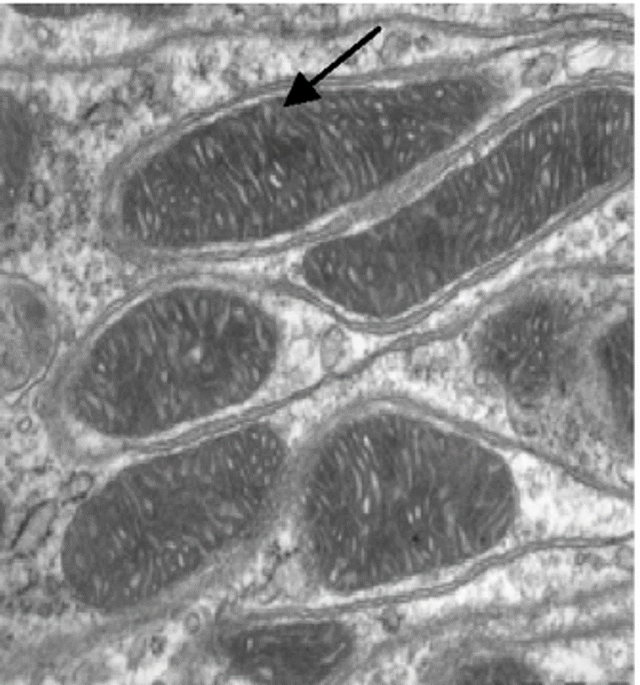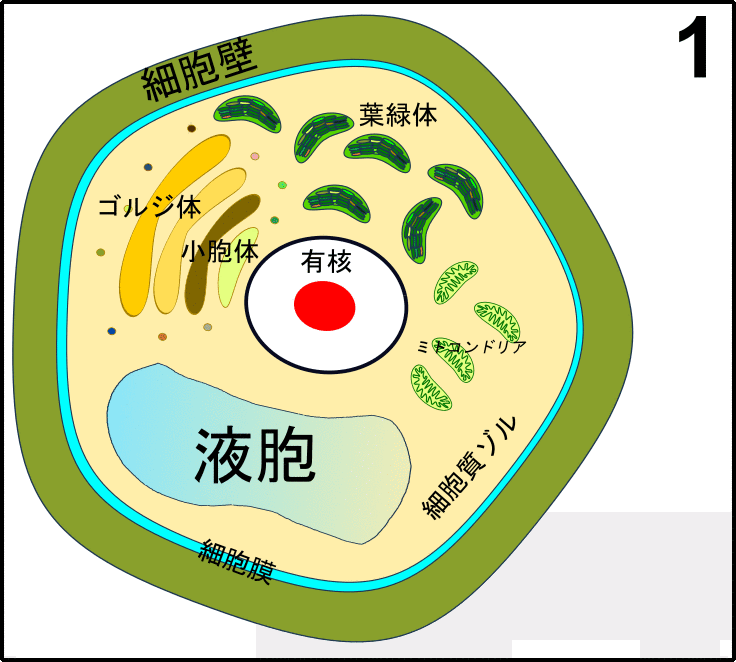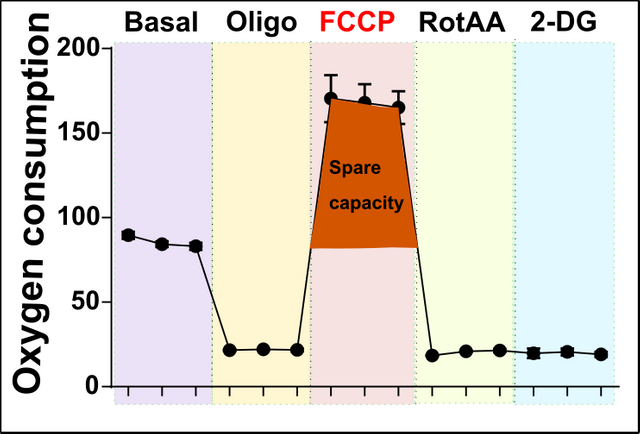Nice paper: Don’t trust the mitochondrial spare capacity!?!
I have to read many papers all the time. Often I’m not that happy with the content, but occasionally I feel a lot of joy by reading them.
This week I came across a publication by Giordano et al. 2013 [1].
The article deals with a mitochondrial dysfunction called LHON.

Fig.1 How you can imagine mitochondria in your cells. Electron microscopic image from Chen et al. 2013 [2]. CC-BY license.
Mitochondria are the power plants within your cells responsible for the production of >90% of the ATP (energy) you need (depending on cell type) [3-6]. LHON is a disease which is primarily caused by mutations within the mitochondrial genome [1, 7-9]. Single mutations within the genome of the mitochondria are sufficient for showing LHON symptoms [1]. These mutations primarily occur in mitochondrial genes encoding for Complex I of the respiratory chain (see GIF1 below) [1, 7]. (I will discuss all this in detail when I translate my German mitochondria articles here, here and here into English).
The consequence is that the affected people are getting blind, often when they are young adults. Mainly men show LHON symptoms, which is probably related to a low amount with estrogens [1].
But also smoking, alcohol consumption or stress can trigger LHON [1].
Therefore, you can conclude that a mitochondrial dysfunction like this is potentially avoidable. Many findings pointing to the assumption that LHON is the result of an interplay between genetic, hormonal and environmental factors.
As you probably still know from my autophagy posts you can select damaged mitochondria and degrade them (called mitophagy).
In the case of LHON 100% of all mitochondria are mutated after a while. But even when this is the case you not necessarily show LHON symptoms.
This is what Giordano et al. 2013 have researched.
But why is this paper so important to me?
With the Seahorse techniques you can monitor the activity of the respiratory chain (please also see my #gifs4science article here).

GIF1: This is the normal mechanism of the respiratory chain. For more information please see here. Made by Chapper - unrestricted use allowed
After adding FCCP the cells are starting to consume high amounts of oxygen. This is because the proton gradient is uncoupled by FCCP. Protons are separated at the mitochondrial membrane to produce an „energetic“ force (called the proton motive force) comparable to a hydroelectric power station. The cells are trying to reestablish the proton gradient but fail because FCCP transports the protons back again anytime. In the analogy to a hydroelectric power station, you can imagine this as „channels“ which transport the water back to the valley without passing turbines.
The increase in oxygen consumption after addition of FCCP is called spare capacity.

Fig.2: With the Seahorse technology, you can figure out the strength of the spare capacity after addition of FCCP which is the highest oxygen consumption rate your cells are able to display. Chapper’s platelets in a Seahorse. For further details please see here. Made by Chapper - unrestricted use allowed
It is discussed that high spare capacity indicates good health. The reason is the speculation that the spare capacity shows hidden energy packages which will be mobilized upon high energy demand. However, I always had problems with this dogma because I think it’s an incomplete assumption.
In the paper of Giordano et al. 2013 [1] they investigated in three groups of test persons the amount of mitochondrial DNA and the concentration of proteins within the mitochondria.
These three groups were:
- control patients with no LHON mutation
- LHON mutation carriers with mutations and symptoms of LHON (affected)
- LHON mutation carriers with mutations but no symptoms of LHON (unaffected or carriers)
At first, they investigated the amount of mitochondrial DNA in the three groups.

Fig.3: Amount of mitochondrial DNA per cell (in white blood cells) according to Giordano et al. 2013 [1]. CC-BY license.
After studying the amount of mitochondrial DNA (in white blood cells) they found that affected and unaffected patients have higher mitochondrial DNA content than controls. This is pretty interesting because many people argue that the more mitochondria you have the healthier you are. I also had problems with this because I think:
When you need a lot of things to stay alive, why should this be good?
In fact, many mitochondria are good in the case when you are prone to diseases such as LHON. But for a healthy individual, is this argument a kind of weird.
Moreover, Giordano et al. 2013 [1] studied the amount of mitochondrial protein content in white blood cells and found the same pattern.

Fig.4 Western blot analysis in white blood cells of patients with LHON mutations which are affected or unaffected (carriers) in comparison to mutation-free controls according to Giordano et al. 2013 [1]. CC-BY license.
**Controls have the lowest content of mitochondrial proteins **. Affected people (LHON carrier + symptoms) had elevated levels and unaffected (LHON carriers + no symptoms) had the highest load with mitochondrial proteins.
This, in turn, means: With more mitochondria, you have more mitochondrial proteins. Therefore, you can consume more oxygen and would have a higher spare capacity.
Don’t get me wrong. In the case of skeletal muscle cells, it is probably better to have more mitochondria because your muscles need a lot of energy, such as in the case of sportsmen. In turn, when you are not doing sports and have therefore no excess muscle work, why should you have many mitochondria?
Giordano et al. 2013 [1] also investigated the number of mitochondria in skeletal muscle cells and came to the same conclusion as in the case of white blood cells.
These findings indicate that the assumption of the „good“ high spare capacity needs to be reviewed.
Nonetheless, in another article, the researchers created LHON-like mutations in fibroblasts of mice and obtained findings in another direction [12]. The authors found that LHON cells had lower respiratory activity than the control cells. Even though this design is highly artificial it is an argument against my hypothesis.
Like every study, also Giordano et al. 2013 [1] has some weaknesses such as small sample size (25 affected, 38 unaffected, 54 controls), no measurement of oxygen consumption or acidification, as well as a bit messy Western blots. Additionally, many of the patients are related to each other (e.g. same families).
Actually, I haven’t found any publication where Seahorse measurements were made with material of LHON patients. As long as something like hasn’t been made, no final conclusion is possible.
Besides the aspects I discussed above, the authors did a lot of other interesting research concerning the metabolism and mitochondrial activity of LHON patients but for me, this should be enough for the moment.
I just want to show you that reading scientific articles could be very funny, at least when you have a basis from where you start your journey.
Thanks for reading
and Steem on
Chapper
References:
- Giordano, C., et al., Efficient mitochondrial biogenesis drives incomplete penetrance in Leber's hereditary optic neuropathy. Brain, 2014. 137(Pt 2): p. 335-53.
- Chen, J.F., et al., Improved mitochondrial function underlies the protective effect of pirfenidone against tubulointerstitial fibrosis in 5/6 nephrectomized rats. PLoS One, 2013. 8(12): p. e83593.
- Müller-Esterl, W., Biochemie: Eine Einführung für Mediziner und Naturwissenschaftler. 2004: Spektrum Akademischer Verlag.
- Myhill, S., N.E. Booth, and J. McLaren-Howard, Chronic fatigue syndrome and mitochondrial dysfunction. Int J Clin Exp Med, 2009. 2(1): p. 1-16.
- Brand, M.D. and D.G. Nicholls, Assessing mitochondrial dysfunction in cells. Biochem J, 2011. 435(2): p. 297-312.
- Püschel, Taschenlehrbuch Biochemie. 2011: Thieme Verlagsgruppe.
- Suomalainen, A. and B.J. Battersby, Mitochondrial diseases: the contribution of organelle stress responses to pathology. Nat Rev Mol Cell Biol, 2018. 19(2): p. 77-92.
- Kirches, E., LHON: Mitochondrial Mutations and More. Curr Genomics, 2011. 12(1): p. 44-54.
- Wallace, D.C., Mitochondrial DNA mutations in disease and aging. Environ Mol Mutagen, 2010. 51(5): p. 440-50.
- Tomas, C., et al., Cellular bioenergetics is impaired in patients with chronic fatigue syndrome. PLoS One, 2017. 12(10): p. e0186802.
- Hill, B.G., et al., Integration of cellular bioenergetics with mitochondrial quality control and autophagy. Biol Chem, 2012. 393(12): p. 1485-1512.
- Fayzulin, R.Z., et al., A method for mutagenesis of mouse mtDNA and a resource of mouse mtDNA mutations for modeling human pathological conditions. Nucleic Acids Res, 2015. 43(9): p. e62.
Thanks for sharing this! I really enjoy reading summaries of papers out of my field (I am actually trying to do the same within my field, hoping to attract the interest of someone in the process).
Good question. I would tend to think the opposite: the less one needs to be healthy, the better it is. No? :)
Hey @lemouth, this is exactly I want to transport with this post. All researchers and physicians think the more mitochondria you have the better is your health. But besides the fact, that mitochondria are producing reactive oxygen species (ROS) an elevated number is, for me, a sign of inefficiency. I will keep this issue on my priority list when I find more good paper, such as this, I will continue the argumentation.
Regards
Chapper
I feel as though I'm peeking over your shoulder in the laboratory, when I read this, especially when I get to see "Chapper's platelets in a seahorse." Interesting, following your thought process as you weigh pros and cons of this 'argument'.
Hope you keep us up-to-date as your work evolves. I'm learning a lot about mitochondria :)
(Resteem)
No wonder why mitochondria are defined as 'power plants'. They even have their very own tag on Steemit! 😃 All of a sudden I became more interested in them 😆
I will put some more Infos on the blockchain within a few weeks! I think it's important to share this knowledge.
Thanks for your interest!
Best
Chapper
Posted using Partiko Android
For sure!! Please do :D
Thanks @agmoore,
I do my best. And as long I haven't understood how mitochondria really work prevent:
Best
Chapper
😄 That sounds apocalyptic!
What I need to know is, can we undo the past? At this point in my life, I think my mitochondria are beyond redemption.😁
Laughter! Reading this list, my first thought is: traveling back in time where no consumption goods, civil illnesses and bad food existed. Probably I would have to go back to hunter gatherer nomads. Where substitutes for the above list would be:
As much as avoidance of the listed things I agree with, for the most part its hardly possible.
LOL: "everything that is bad". I must agree though I said it otherwise.
At least you can try to avoid some of the worst things such as Smoking, junk-food and stress. Then proceed with other things such as Sports or mind-set. At the end you will be surprised how easy it actually is.
I will make a Video and more Posts concerning these aspects within the next weeks and months.
To live healthy is much easier than living unhealthy!
Chapper
Posted using Partiko Android
I was kidding about my answer. In fact, I am a great supporter of all the things you have enumerated to avoid. But the list seems pretty unfulfillable the first time I read it, so I made a joke.
👍got it! Making jokes is probably also good for your mitochondrial health 😉
Posted using Partiko Android
:-)
Hi @chappertron!
Your post was upvoted by Utopian.io in cooperation with @steemstem - supporting knowledge, innovation and technological advancement on the Steem Blockchain.
Contribute to Open Source with utopian.io
Learn how to contribute on our website and join the new open source economy.
Want to chat? Join the Utopian Community on Discord https://discord.gg/h52nFrV
thanks @utopian-io
The sample size in these experiments is so small. D:
That's my main critic on the publication!
Have a nice Weekend!
Posted using Partiko Android
I do agree with you about how enjoyable reading scientific articles can be @chapperton. And, I must confess, I am quite drawn to reading articles from the biology field. Still, this will not come as a surprise to you, I am sure: I had never heard of LHON disease before. But, it is always interesting to learn about the outcome that may result from the interactions environmental and biological factors have on one another. Particularly when they can bring devastating consequences such as blindness.
Thank you for taking the time to share all this info with us :)
Best,
Abigail
Hey and thanks to you for coming by!
The problem with mitochondrial dysfunction is that they are hard to figure out. There are worst cases of people having this from birth on. Then there are numerous diseases which are accumulation throughout life because of various factors. And then there is something like LHON which is in between. That means you are genetically prone to receive this but you also can trigger it by various factors.
In general, most physicians can't figure this out. It's too complex and to multifaced.
Once you have this, it is almost too late, because there is no reliable therapeutic strategy against it. But there are interventions which prevent the accumulation of mutations, such as less stress, good food, no toxins...
I made a German article series concerning this, the translation will be published in a few weeks.
Stay healthy and have a nice weekend
Chapper
Well, thank you for the additional info :D
Your welcome 👍😉
Posted using Partiko Android
This post has been voted on by the SteemSTEM curation team and voting trail. It is elligible for support from @utopian-io.
If you appreciate the work we are doing, then consider supporting our witness stem.witness. Additional witness support to the utopian-io witness would be appreciated as well.
For additional information please join us on the SteemSTEM discord and to get to know the rest of the community!
Please consider setting @steemstem as a beneficiary to your post to get a stronger support.
Please consider using the steemstem.io app to get a stronger support.
Thanks guys! Have an ice Weekend 😎
Posted using Partiko Android
This post is supported by $1.14 @tipU upvote funded by @balte :)
@tipU voting service: instant, profitable upvotes + profit sharing tokens | For investors.
Wow thanks again @balte!
You are the good spirit of our community.
Have a nice Weekend and Steem on
Chapper
Posted using Partiko Android
To listen to the audio version of this article click on the play image.

Brought to you by @tts. If you find it useful please consider upvoting this reply.
Nice idea, thank you!
Thanks for this interesting and challenging post!
Thank @zuerich, I enjoy challenging;-)
Hi, @chappertron!
You just got a 0.23% upvote from SteemPlus!
To get higher upvotes, earn more SteemPlus Points (SPP). On your Steemit wallet, check your SPP balance and click on "How to earn SPP?" to find out all the ways to earn.
If you're not using SteemPlus yet, please check our last posts in here to see the many ways in which SteemPlus can improve your Steem experience on Steemit and Busy.
👍
Posted using Partiko Android